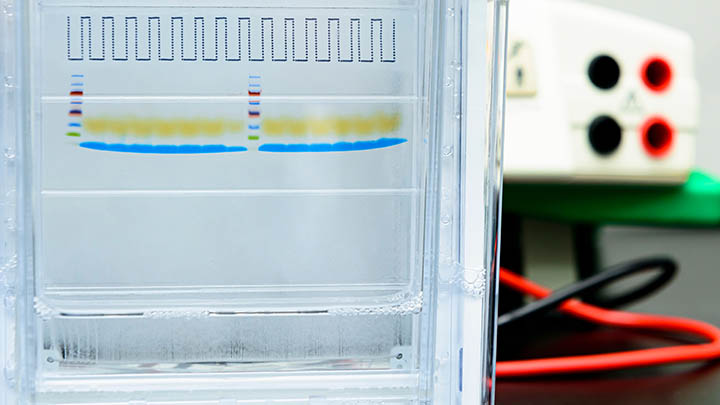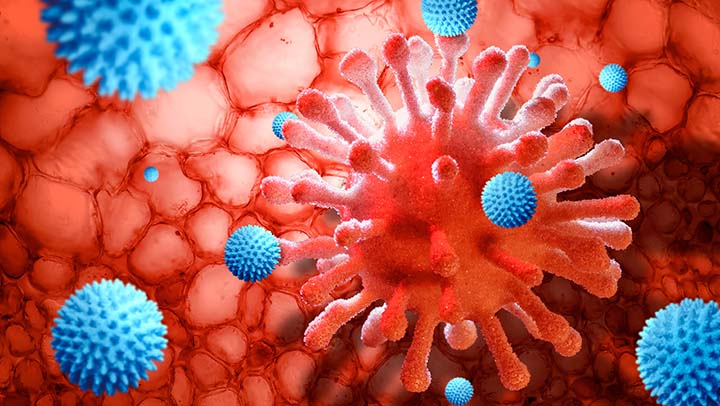Cutting-edge tools and techniques for investigating the physical properties of molecules
The Biomolecular Analysis Core Facility is much more than a room full of instruments.
We are a technical resource and knowledge base with the aim of aiding research programmes, teaching, technical and scientific development and bringing together a wider scientific community who share similar biophysical questions.
How we work
Supporting your biomolecular project
Our technologies focus on the fundamental biophysical properties of molecules, their hydrodynamics, thermodynamics and optical properties which allows us to interrogate their structure, stability, interactions and dynamics in solution.
Please contact us with your query in the first instance.
Underpinning your project's lifecycle
We support research from concept to publication, incorporating education, advice, sample preparation, analysis, instrumental training, data interpretation and reporting. We also provide services to other higher education institutions and industry.

Advice
We have a large array of instrumentation and methodologies, so are always happy to advise on the most appropriate techniques for your project, including optimisation of sample quality and quality control.

Applications
Our focus
Our applications focus on hydrodynamics, protein interactions, protein stability, buffer optimisation and nanobody screening.
Typical applications include:
Protein molecular mass and oligomerisation
Investigation of protein molecular mass and oligomerisation using light scattering and analytical ultracentrifugation.

Protein interactions and kinetics
Protein interactions and kinetics using SPR and MST and ITC.

Isolation of antibody mimetics
Yeast display technology for the isolation of antibody mimetics (nanobodies).

Events and interactions
Complex binding events, whole-cell interactions, lipid bilayers and nanotechnology.

Protein stability
Protein stability, folding, thermodynamics and buffer optimisation.

Protein purification
Next-generation protein purification systems.

Technologies and equipment
Up-to-date technology and methods
We have a broad suite of instrumentation, and frequently acquire and develop new methods and techniques.
For access to any of these systems please contact us.
Protein interaction technologies vary from surface sensor technologies such as SPR to in-solution techniques like ITC and MST or even AUC. There are several factors which determine which technique is likely to be most successful and it depends on the ultimate question and the molecules involved.
We suggest talking to facility staff early in a project as buffer optimisation, protein tags and purity are all factors that need to be considered.
We have the following equipment available in this area:
Biacore T200 surface plasmon resonance
4-channel surface interaction instrument with extremely high sensitivity suitable for small molecule interactions.
Bionavis 220 Naali Multi-parametric SPR
SPR with the ability to use the whole SPR curve to establish layer thickness.
Octet Red96 Biolayer interferometry
8-sensor interferometer for multi-well interaction analysis.
Nanotemper Microscale Thermophoresis (MST) Monolith Pico
In-solution protein interaction analysis system using one fluorescently labelled target. Suitable for a wide range of interaction analysis from small molecule screens to protein-protein interactions.
PEAQ ITC Isothermal Titration Calorimetry
The gold-standard in thermodynamics of protein interactions. We have the newest Malvern instrument the PEAQ instrument with low signal to noise reduced sample consumption.
Several of our instruments are ideal for designing methods for more complex protein interaction analysis. This could be real-time monitoring of cell interactions/cell growth and cell motility to the analysis of fibrillation, lipid bilayers and complex formation.
We often use these systems for ligand fishing experiments and fabrication of multi-layer surfaces such as graphene and cell membrane mimetics.
QSense Omega Quartz crystal microbalance with dissipation monitoring (QCM-D)
This instrument is an 8-sensor piezoelectric resonator which is excellent for monitoring mass association to surfaces as well as their viscoelastic properties, such as fibrillar vs rigid layers. Often used for lipid bilayer formation and subsequent macromolecule interactions.
BioNavis MP-SPR 400 Konti
This state-of-the-art multi-parametric SPR is ideal for cell interactions, where cells can be grown on the sensors and subsequent binding events can be monitored.
N-Lab SEEC microscopy
This innovative instrument combines surface enhanced microscopy with ellipsometry to provide unrivalled live-cell imaging and surface interaction analysis.
We place a large emphasis on protein quality control. This is extremely important for accurate and reliable results and often a short time investigating protein stability saves time and money overall and reduces uncertainty.
These instruments incorporate light scattering, circular dichroism and UV to investigate melting temperatures Tm, aggregation onset temperature Tagg, folding and purity.
UNcle Unchained labs
This instrument uses very low protein volumes of 8.5 μl in a 48-well format and measures dynamic and classical light scattering, and tryptophan fluorescence whilst heating the samples to obtain melting and aggregation onset temperatures. It can be useful also for ΔG, and small molecule screening.
Jasco J810 Circular dichroism
Measures near and far UV for relative levels of structural fold characteristics.
Jasco V-750 UV-Vis
We have a dual beam scanning UV vis spectrometer.
Horiba Fluorescence spectrometer
We use classical light scattering in the form of multi-angle light scattering from Wyatt and analytical ultracentrifugation to investigate mass and oligomerisation of molecules.
Wyatt HeliosII, REX and Qels multi-angle light scattering (MALS)
This 18-angle light scattering detector detects the absolute mass and concentration and radius (hydrodynamic and radius of gyration) of molecules as they elute from a gel filtration column. Extremely useful to check for the oligomeric state and purity of your molecules. Accuracy is to within 1% total mass.
XLA and XLI analytical ultracentrifuges
These powerful instruments can monitor the sedimentation of molecules in a centrifugal field which gives rise to information such as molecular shape and mass. They are used often to monitor conformational changes, kinetics of oligomerisation and for building low resolution structural models of macromolecules.
The facility has a dedicated nanobody yeast display platform and next-generation Bio-Rad NGC protein purification systems.
Publications and outputs
Regularly contributing to quality research outputs
The Biomolecular Analysis Core Facility has contributed to hundreds of research papers, grants, workshops and presentations.
Here are some of the highlights.
ACS Publications, 2020.
The facility has been forefront in the development of a new piezoelectric biosensor with applications for identification of patients with membranous nephropathy.
Journal of Biological Chemistry, 2020.
The facility played an extensive role in the analysis of the structure and function of IαI with the Day group.
Nature Communications, 2019.
The facility helped identify the interactions partners, and function of P43 in whipworm parasite infection with the Grencis group.
European Biophysics Journal, 2021.
The nanobody yeast display and facility has developed a range of standards for use in biophysics.
External access
Working with industry and other academic institutions
Although primarily focused on supporting research at The University of Manchester, we are also able to support work from other academic institutions and industry.
If you are interested in accessing the facility please contact our Business Development Manager for further details:
Dr Joanne Flannelly
Email: joanne.flannelly@manchester.ac.uk
Academic institutions
Our capacity for performing external work is dependent on the availability and current usage levels of the platforms required, and also on the complexity of the work to be performed.
Please contact the Facility Manager for further details:
Dr Tom Jowitt
Email: t.jowitt@manchester.ac.uk

Industry
We have worked for a number of multinational companies, both on an individual basis and as part of packages of work involving multiple facilities.
Work may be on a collaborative basis or purely as a service provision.
All work is fully documented and contractual, and non-disclosure compliance is assured.

Contact us
Find out more
Get in touch for further information or to inquire about using our facility.
Dr Thomas Jowitt, Senior Experimental Officer
Email: t.jowitt@manchester.ac.uk
Tel: +44 (0)161 306 5176
Address:
Biomolecular Analysis Core Facility
Faculty of Biology, Medicine and Health
D.3402 Michael Smith Building
The University of Manchester
M13 9PT
Maps and travel
We are based in the Michael Smith Building (Building 71 on the University campus map).
Technology platforms
Technology platforms
We have a pioneering environment and facilities for research, innovation and technology development.
Technology platforms main page
